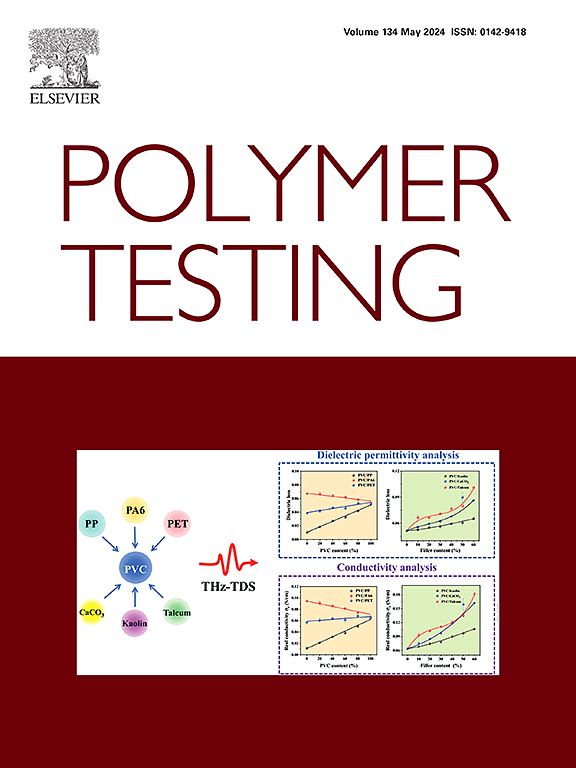用于定量跟踪异氰酸酯含量的中红外和近红外光谱:特种聚氨酯反应挤出合成监测工具的流线型发展
IF 5
2区 材料科学
Q1 MATERIALS SCIENCE, CHARACTERIZATION & TESTING
引用次数: 0
摘要
强大的现场监测可以加快反应挤出(REX)工艺的开发和调整,特别是对于需要深入了解反应过程的聚合物的合成,例如特种聚氨酯(pu)。为了提高这种分析的可行性,我们的研究集中在一种光谱方案上,该方案结合了实验室挤出机中的在线中红外(MIR)和在线近红外(NIR)测量,评估了它们的定性和定量能力。为了模拟聚合过程中反应性物质的消耗,在非反应性条件下,使用多元醇和二异氰酸酯的基准对配制了一系列预混料并进行了表征。通过这种方法,我们通过多元回归模型确定了量化异氰酸酯含量的合适光谱特征。该方法实现了MIR和NIR模型的良好校准指标,并通过交叉验证对其预测性能进行了稳健评估,仅使用了适量的光谱数据集。因此,我们的工作是朝着建立过程中近红外分析方法的第一步,该方法具有简化的在线MIR验证。它为设计基于原始试剂光谱数据的定量校准的PUs和其他材料系统的监测REX合成提供了一条捷径。本文章由计算机程序翻译,如有差异,请以英文原文为准。
Mid- and near-infrared spectroscopies for quantitative tracking of isocyanate content: Streamlined development of monitoring tools for reactive extrusion synthesis of specialty polyurethanes
Robust in-situ monitoring can expedite the development and tuning of reactive extrusion (REX) processes, especially for the synthesis of polymers requiring insight into the reaction course, such as specialty polyurethanes (PUs). In order to advance the feasibility of such analysis, our research concentrated on a spectroscopic protocol that combines at-line mid-infrared (MIR) and on-line near-infrared (NIR) measurements in a laboratory extruder, assessing both their qualitative and quantitative capabilities. To mimic the depletion of the reactive species during polymerisation, a series of premixes were formulated and characterised under non-reactive conditions using a benchmark pair of a polyol and a diisocyanate. By this means, we identified suitable spectral features for quantifying isocyanate content via multivariate regression models. This approach achieved good calibration metrics for both MIR and NIR models and enabled a robust assessment of their predictive performance through cross-validation, using only a moderate number of spectral datasets. Our work is therefore the first step towards establishing a method for in-process NIR analysis with streamlined at-line MIR verification. It provides a shortcut for designing monitored REX syntheses of PUs and other material systems amenable to quantitative calibration based on spectroscopic data from raw reagents.
求助全文
通过发布文献求助,成功后即可免费获取论文全文。
去求助
来源期刊

Polymer Testing
工程技术-材料科学:表征与测试
CiteScore
10.70
自引率
5.90%
发文量
328
审稿时长
44 days
期刊介绍:
Polymer Testing focuses on the testing, analysis and characterization of polymer materials, including both synthetic and natural or biobased polymers. Novel testing methods and the testing of novel polymeric materials in bulk, solution and dispersion is covered. In addition, we welcome the submission of the testing of polymeric materials for a wide range of applications and industrial products as well as nanoscale characterization.
The scope includes but is not limited to the following main topics:
Novel testing methods and Chemical analysis
• mechanical, thermal, electrical, chemical, imaging, spectroscopy, scattering and rheology
Physical properties and behaviour of novel polymer systems
• nanoscale properties, morphology, transport properties
Degradation and recycling of polymeric materials when combined with novel testing or characterization methods
• degradation, biodegradation, ageing and fire retardancy
Modelling and Simulation work will be only considered when it is linked to new or previously published experimental results.
 求助内容:
求助内容: 应助结果提醒方式:
应助结果提醒方式:


